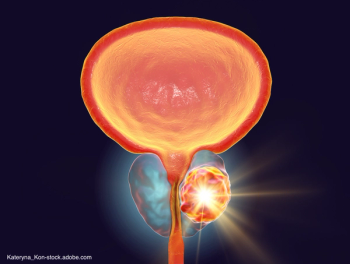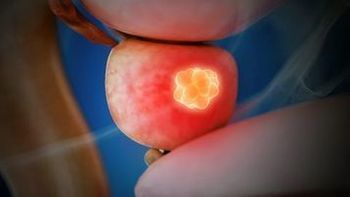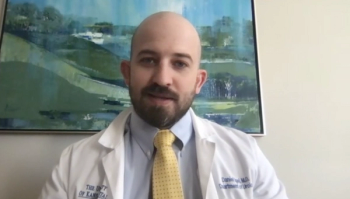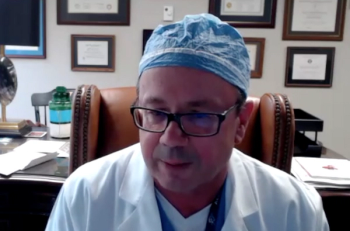
“We were able to develop a machine learning model that had decent accuracy…in predicting which patients would have an additional stone event and which patients wouldn't,” says Kevin Shee, MD, PhD.

“We were able to develop a machine learning model that had decent accuracy…in predicting which patients would have an additional stone event and which patients wouldn't,” says Kevin Shee, MD, PhD.

“What we found is that the use of these drugs and novel hormonal therapies and chemotherapy in the metastatic castration-sensitive setting was relatively low,” said Stephen J. Freedland, MD.

Dr. Goldberg discusses his findings on the rates of shared decision-making and PSA testing, which were presented at the NSAUA meeting in Charlotte, North Carolina.

“When we think about all the other office-based procedures we do, such as transrectal biopsies and vasectomies that are done in-clinic, I think that technology can play a big role in these," says Dr. Myrga.

“We do know that for these specific racial minorities, more time and more tools need to be invested in order to have both the rates of PSA discussion and PSA testing equal to those that White men have,” says Hanan Goldberg, MD, MSc.

“It didn't happen overnight. The way we built the program was an iterative process,” says Shubham Gupta, MD.

“What was found in the sub stratification study was that overall survival favored the addition of darolutamide to ADT and docetaxel in all stratification subgroups,” says Ronald Tutrone, MD, FACS, CPI.

“This equation that is true for White men, where more discussion leads to more PSA testing, did not hold for racial minorities,” says Hanan Goldberg, MD, MSc.

Dr. Elterman discusses the findings of his recent study on the use of sacral neuromodulation to treat various conditions, which was presented at the NSAUA Annual Meeting.

“The biggest finding is that we are seeing a steady increase in women representation in the field of urology,” says Teresa L. Danforth, MD.

“So yes, these transperineal biopsies are more painful right in the moment, but immediately following that, these patients are comfortable," says John Myrga, MD.

John Myrga, MD, discusses recent findings on levels of pain, anxiety, and embarrassment for patients undergoing a prostate biopsy with a transperineal approach versus a transrectal approach.

“We have helped developed policies at the national level as far as parental leave for residents and fellows, helping to streamline a lot of that process with the American Board of Urology,” says Daniel Igel, MD.

“I think the take home message of this study is that there's work to do, and that our efforts in diversity, equity, and inclusion extends broadly beyond simply ensuring that we have the workforce to treat our diverse population, or that urologists are thinking critically and responsibly about the needs of our patients,” says Kevin Koo, MD, MPH.

“One thing that from the very beginning we talked about is how can we push this forward? How can we think outside the box and take this to the next level to make an impact for our patients?” says Katie Murray, DO, MS.

Two studies shared at the 2022 Annual Meeting of the South Central Section of the AUA highlighted onabotulinumtoxinA and sacral nerve stimulation as alternative treatment options for patients older than 70 years with overactive bladder.

“The main finding of the study was that, like…other clinical trial studies in the past, we also found that there was an over representation of non-Hispanic White patients in these trials, and a dramatic under representation of people traditionally and historically underrepresented in clinical trials and in medicine,” says Kevin Koo, MD, MPH.

“A majority of the patients who were referred who had a catheter pre embolization are now catheter free,” says Kimberly Kocour, MD.

“This concept of adding additional therapy early on is ready for primetime,” says Michael S. Cookson, MD, MMHC.

“[With] some folks, if you don't accurately risk stratify them, you miss your chance to really build that trust as a provider,” says Neil Mistry, MD, MPH.

“There was about a 32.5% survival advantage for patients with that triple therapy,” says Michael S. Cookson, MD, MMHC.

"The biggest advantage of this technique is that because the sound waves are coming from inside and going outwards, it doesn't destroy anything beyond the prostate, at least in theory,” said Michael Koch, MD.

“We actually found that our calculator held up pretty well at different risk thresholds, especially when compared to the PCPT in terms of maintaining the same number of missed cancers, but cutting the number of biopsies that were not necessary nearly in half,” says Neil Mistry, MD, MPH.

"Our goal is to understand the lived experiences of people on gender-affirming hormonal therapy, as it relates to their urinary and sexual health,” said first author Paige De Rosa, MD, urology resident at the University of Iowa, Iowa City.

Senior author Kevin Ginsburg, MD, said he and his coauthors observed wide variation by practice in the use of active surveillance in this patient population.